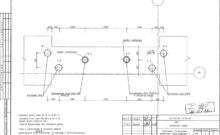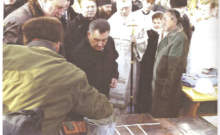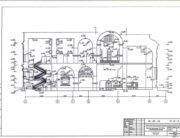The fate of the Assumption Cathedral in the war years was not so joyful. In 1918, as a result of an artillery bombardment, the Assumption Cathedral was destroyed and a special commission consisting of representatives of the Kiev Scientific Archival Commission, the Society for the Study of the Arts and the Kiev Society for the Preservation of Ancient Monuments and Art was created to examine it. In 1919, as a result of the work started on the inventory and description of the churches, in order to determine their historical and artistic value, the Assumption Cathedral was surveyed and photographed. This period was marked by an increase in the level of research of the cathedral, in particular, in 1937, under the direction of I. V. Morgilevsky, special in-depth architectural and archaeological research and measurements of the Assumption Cathedral were carried out.”
The study of Morgilevsky was interrupted due to the Great Patriotic War. ”
During the temporary occupation of Kiev by the fascists in 1941-1943, on November 3, 1941, the Assumption Cathedral was blown up. “Regarding the one who destroyed the Assumption Cathedral, there are different opinions expressed in a number of publications.” During the occupation, the Tsar’s Gates of Silver, 120 silver robes, silver altar ornaments of the altar and the altar, the Gospel in silver frames, etc. were removed from the Assumption Cathedral to Germany, and only a small part of the legs could be returned. “In October 1942, the fascists created a special“ office ”, which was engaged in dismantling the destroyed structures, including Assumption Cathedral. Mostly from the ruins, building materials were suitable for further use: copper from domes, wooden products, etc. “.
After the end of the Second World War, the activity of the Kiev-Pechersk Reserve was restored. In 1945, the architectural workshop, which was led by Professor NN Demin, performed measurements for estimating the work. Already in the first post-war years, restorers developed methods for restoring a ruined cathedral, including the well-known restorers PD. Baranovsky, L.P. Sukhov suggested “not only the walls of the church should be used in the restoration of the cathedral, but all the large blocks that survived were organically incorporated into the newly restored building volumes”.
“In November 1945, the results of a survey of the ruins of the cathedral, performed by engineers P. Grishin and LK, were reviewed at the Office of Architecture Affairs at SNK-USSR. Lyubimov. In December of the same year, the corresponding calculations were carried out and a project was made to strengthen the John the Theologian side chapel and the southern apse of the ancient temple center. ” Work was carried out to dismantle the ruins of the cathedral, and in September 1946, under the guidance of Professor L. G. Leontovich, the volumes of the rubble of the Assumption Cathedral were calculated, which remained after the dismantling of the cathedral ruins in 1945 .. In 1945, the staff of the Kiev-Pechersk Nature Reserve carried out architectural -archaeological studies of the cathedral. At the same time, the “design task for the restoration” of the John the Theologian Chapel and the altar part of the southern Navi was developed, and in the autumn of 1946 the corresponding project was developed and approved. “From 1946 to 1948, the John-Theological side-chapel, the southern part of the 11th-century cathedral, was cleared of rubble. and an extension in which the sacristy was located. ” During 1946-1949, relevant reports and scientific publications were made, which covered the history of the Assumption Cathedral. In 1947-1948, most of the rubble was removed, and in 1951 and in June-October 1952, the next stage of architectural and archaeological research began under the direction of M. V. Kholostenko. In 1954, the ruins were partially dismantled in the direction from west to east. In the post-war years, the scientific research of building materials and structures of the Assumption Cathedral was mainly continued, which were based on field surveys, photo fixations and laboratory studies of samples, which allowed us to classify samples of plinfs, plaster, and solutions. In 1955, the results of studies of previous years were published. So, the surveys of 1945-1954 allowed to enrich the knowledge of construction equipment and building materials of the Old Russian period.
Since July 1962, the last period of dismantling the rubble of the Assumption Cathedral was held during the year, which allowed determining the status of preserving the cathedral’s structures, identifying emergency destructive sites, samples of building materials, as well as continued measurement and research work. In 1963, two variants of the conservation project for the ruins of the Assumption Cathedral were developed, on the basis of which they prepared “proposals for the conservation of the object, which were implemented in 1965-1967”.
“In the years 1980-1981. As part of the work on the historical and architectural substantiation of the prospective development of the Kiev-Pechersk Nature Reserve, the foundations for the restoration of the Assumption Cathedral were developed, and in 1981 the Kiev City Executive Committee and the State Construction Committee of Ukraine approved the program-task of developing the restoration project of the Assumption Cathedral. In 1982-1986, additional archaeological surveys of the Assumption Cathedral, especially its foundations, were conducted, searches of new archival sources were conducted, made adjustments to the building history of the cathedral and allowed the reconstruction of the architectural appearance of the cathedral as it was during various construction periods.



















